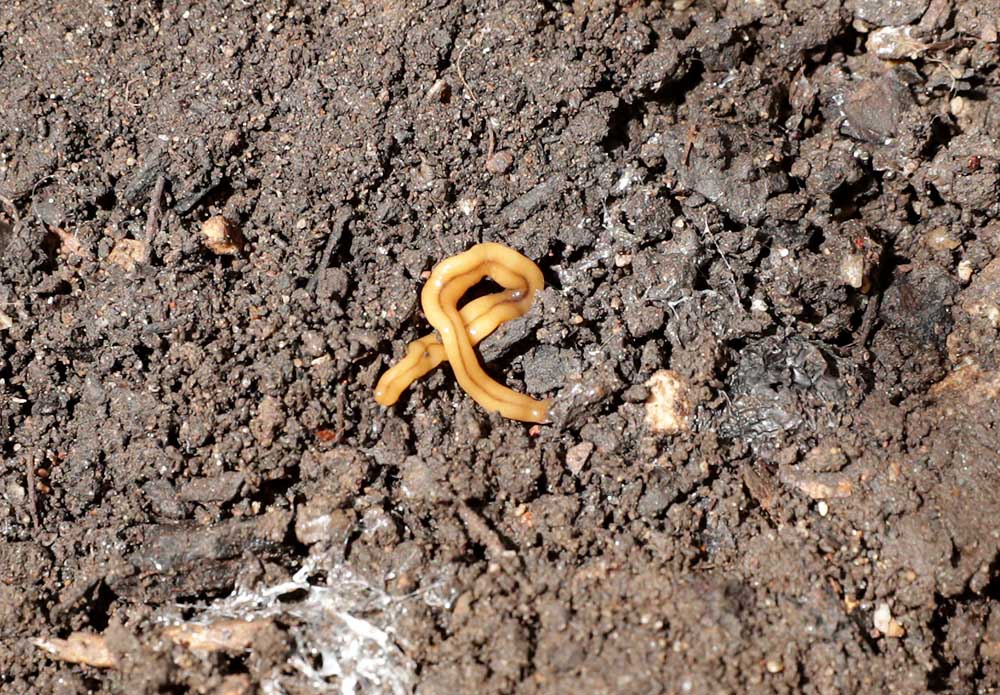Invasive, toxic flatworms found in west Medford garden
Published 10:09 am Friday, April 21, 2023

- A flatworm, an invasive species that contains a potent neurotoxin, wiggles through the dirt in Medford.
Kevin Orella recognized the invasive, toxic flatworms the moment he found them wriggling in his west Medford garden bed.
Just to be sure, with gloved hands he picked up the worms and laid them on stones to see whether they would reveal a tell-tale “hammerhead.”
“When they’re under rocks and things, you can’t immediately see it. You have to take ’em out and let ’em crawl, and then as they move, their heads fan out,” Orella said.
A third-generation gardener and amateur entomologist, Orella saw the worms as a distant pest and one he was grateful not to have in his own backyard — until April 12.
“I was out there pulling weeds and moving stones, getting the beds ready for planting, and I was finding those critters everywhere,” he said.
The worms have the same neurotoxin found in pufferfish. It’s one of the most potent toxins in the world, but the hammerheads don’t contain enough toxin to harm people, unless unsuspecting gardeners working with bare hands touch the worms and then their eyes or mouths. The worms will also likely taste bad to dogs, children or chickens, he said. But they will consume the earthworms gardeners celebrate for their ability to aerate soil and fertilize it with their “casings.”
The biggest concern for Orella was how fast flatworms can multiply. As hermaphrodites, there is no need to match male and female to mate and lay their eggs. They can also essentially clone themselves.
“Don’t chop ’em up. A lot of people, they see a weird looking insect in their yard, they chop it up with their shovel. That just makes more of ’em. You can put them in a sealed plastic bag in the garbage. If you sprinkle a little salt or vinegar on them, that kills ’em, too, but if you do it too much, it’ll make your garden soil sterile,” he said.
After he found the worms, he took one to the Southern Oregon Research and Extension Center office on Hanley Road in Central Point for official identification.
Grace Florjancic, Master Gardener program coordinator at the extension center, confirmed the identification of the flatworm.
“Yes, we often have people bring in mysteries they find in their gardens. When it’s something small like this, we put it under the dissection microscope. We did confirm this was a wandering broadhead planarian,” she said.
The wandering planarian is one of several species of flathead worms, she said, and one of many garden mysteries SOREC will see this year.
SOREC, which houses the plant clinic, identifies various species that come through its doors, then weighs possible risk to local biodiversity. In this case, the toxic little worms are probably not a concern, Florjancic said, because they have likely been in Oregon for a while — though largely undetected.
“I was able to confirm they have been identified in Oregon before, but I wasn’t able to find the exact date they were introduced. But they have been in California since about the 1940s,” she said.
Through citizen scientist uploads to the website iNaturalist — launched in 2008 for photo-based identification of plants and animals — Florjancic could confirm sightings of the worms in Oregon as far back as 2018.
When asked about the potential invasion of toxic flatworms to Southern Oregon, Josh Vlach threw the worm into the wider context — roughly 10 new exotic species are established in Oregon every year, including insects, mites and mollusks, he said.
Vlach, an entomologist at the Oregon Department of Agriculture, pointed to a 2012 study, “Live plant imports: The major pathway for forest insect and pathogen invasions of the US.” It was a revelation for the department, he explained.
“The quantity of plant imports rose substantially during the past 43 years … increasing by more than 500% (an average increase of 51 million plants per year) to a maximum of 3.15 billion plants in 2007,” the study said.
“We were both blown away and like, ‘Oh, so that’s why this is happening,’” he said.
The popularity of nursery plants shipped from overseas far outstrips the available staff inspecting shipments at major ports, he said, leading to a fight against largely Asian insects that is “kind of relentless.”
“Flatworms are going to eat earthworms, snails and slugs. They can also eat other small invertebrates. But pretty much all the slugs and snails you see are exotic anyway. The impact (from the flatworm) is not that big, but it could be that big if they get into natural areas,” he said.
The forests of Oregon are where the native snails, slugs and worms of Oregon maintain healthy populations. If the wandering planarian ventured there, it might become a concern for the department. Though the flatworms contain a potent neurotoxin, Vlach dismissed public health concerns.
“You have to remember, these are tiny animals. They have enough toxin to kill their prey, but on the scale of humans — you would have to gorge yourself on them,” he said.
The Oregon Department of Agriculture focuses its resources on the highest risk pests. The emerald ash borer — detected in Forest Grove in 2022 — is at the top of the list, Vlach said. Some species, like the brown apple moth and the spongy moth (also called the gypsy moth), have been repeatedly eradicated as they are reintroduced.
“It’s a constant stream really. Some are not that important — they fly under the radar. Some are really important,” said Richard Hilton, a senior faculty research assistant and entomologist with SOREC.
In the struggle against invasive insects, he explained, researchers can employ a risky but often effective tactic seemingly borrowed from B-movie creature-features — bring in another invasive species, a natural predator for the first invader.
“It’s a time-honored tactic. Before we had any insecticides, folks were trying that. A lot of times these invasive species explode because they don’t have those natural predators they co-evolved with,” he said.
In the case of two invasive pests plaguing Oregon fruit harvests — the spotted wing drosophila and the brown marmorated stink bug — researchers have released parasitic wasps known as samurai wasps to fight the new invaders.
“They’re very small. You wouldn’t notice them flying around,” he said.
Sometimes this approach backfires, like the case of certain species of lady beetle introduced to keep another pest in check that became a pest themselves. The lady beetles are now preying on native insects, Hilton said.
Bronze birch borers have been a menace to street trees, while the vine mealybug’s arrival in Oregon vineyards in 2021 was cause for alarm. For the mealybug, researchers are testing a method of disrupting the sex hormones of the invaders to prevent breeding and slowly eliminate the pests.
The battle for supremacy between invasive species, introduced predators and native species is constantly evolving, largely under the nose of human beings, Vlach said.
“It’s a plague that will be a part of humankind forever,” he said.
To learn more about Oregon’s latest invasive species, Florjancic suggested an article, https://extension.psu.edu/hammerhead-flatworms-and-other-land-planaria-of-eastern-north-america
Correction: This article was corrected to state the office for SOREC houses the plant clinic, it originally incorrectly stated the office is also known as the plant clinic. Richard Hilton’s title was also updated to state he is a senior research assistant and entomologist. It originally incorrectly stated he was a senior researcher and entomologist.






